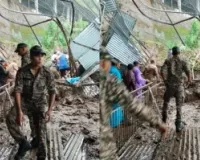Delhi likely to conduct cloud seeding trials: How it works, why it's being tested and what to expect

Why is Delhi testing cloud seeding?
Delhi’s persistent air pollution, especially during the post-monsoon season, has called for innovative mitigation strategies. The government's project, led by IIT-Kanpur and backed by a Rs 3.21 crore budget, aims to use artificial rain to wash out airborne pollutants, potentially improving life expectancy and overall air quality for citizens. Delhi has recorded hazardous PM2.5 levels- averaging 175 micrograms/m³- with severe public health impacts, making alternate interventions critical.
How will the trial work?
Expected impact and next steps
- The operation, cleared by aviation and environmental authorities, involves five flights covering roughly 100 square kilometers in north and outer Delhi, and parts of adjoining Uttar Pradesh.
- Aircraft will disperse hygroscopic particles like sodium chloride and aerosols directly into suitable clouds by flying just below the cloud base.
- Ideal conditions for seeding require nimbostratus (Ns) clouds at altitudes of 500–6000 meters with more than 50 per cent moisture- coinciding with the retreating monsoon period, which experts say increases the likelihood of success.
- Scientific monitoring will track rainwater for chemical residue and evaluate air quality changes post-operation.
If successful, artificial rain could significantly lower PM2.5 and other particulate pollutants, providing a new avenue to combat Delhi’s hazardous winter smog and chronic pollution episodes. The pilot experiment will yield crucial scientific data that, if promising, could lead to larger-scale deployments across the National Capital Region (NCR). The government is prepared to share results with regulatory bodies and environmental specialists to assess the viability for broader use.
Key facts at a glance
- Project cost: Rs 3.21 crore, Rs 55 lakh per trial
- Cloud seeding agents: Silver iodide, iodised salt, rock salt, sodium chloride
- Aircraft and base: Cessna 206-H, Hindon Air Base (Ghaziabad)
- Areas covered: North/outer Delhi and parts of Uttar Pradesh
- Lead agencies: IIT-Kanpur, Delhi Government, IMD, DGCA, IITM Pune
Delhi's cloud seeding trial is poised to be a landmark initiative in urban air quality management, combining advanced meteorology and public health goals.
Trial rescheduled for better weather conditions
Delhi is likely to witness its first cloud seeding trial in the first two weeks of September to trigger artificial rain and reduce air pollution levels, Environment Minister Manjinder Singh Sirsa earlier announced. Originally planned for early July, the trials were postponed following advice from agencies like the India Meteorological Department (IMD), IIT-Kanpur, and the Indian Institute of Tropical Meteorology (IITM), Pune. These experts indicated that July’s weather was not conducive for effective cloud seeding. The rescheduled timeline aligns with the retreating monsoon season, which is expected to provide more suitable cloud conditions for generating rainfall.
Scientific operation using specially modified aircraft
The Delhi government has allocated Rs 3.21 crore for this pilot project, led by IIT-Kanpur’s Department of Aerospace Engineering. The Directorate General of Civil Aviation (DGCA) has granted operational clearance for the trials, which will be conducted using a Cessna 206-H aircraft equipped with cloud seeding instrumentation developed by IIT-Kanpur. The aircraft will avoid restricted zones and adhere to strict aviation safety norms, with no aerial photography during the operation. Five sorties will cover pollution-prone areas in north Delhi- including Rohini, Bawana, Alipur, and Burari- as well as adjoining parts of Uttar Pradesh such as Loni and Baghpat.
Cloud seeding technique and expected impact
During each sortie, the aircraft will fly below the cloud base and release hygroscopic particles such as sodium chloride and aerosols into the clouds to stimulate precipitation. This weather modification technique is designed to induce artificial rain that can help wash out airborne pollutants. According to Sirsa, the initiative is a scientific intervention aimed directly at combating Delhi’s hazardous air quality, especially during the post-monsoon period. If successful, it could open a new avenue for temporary pollution relief in the city’s ongoing fight against toxic air.
About The Author
Welcome to Aryan Age, an English newspaper that has been serving readers since 2011 from Delhi. With a loyal circulation of over 19,000, we are dedicated to providing our readers with the latest news and information, as well as insightful analysis and commentary that help them navigate the complex and rapidly changing world.











Comment List